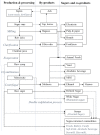Research and Development Prospects for Sugarcane Industry in Vietnam
- PMID: 35281432
- PMCID: PMC8897770
- DOI: 10.1007/s12355-022-01113-7
Research and Development Prospects for Sugarcane Industry in Vietnam
Abstract
Sugarcane is one of the most important industrial crops in Vietnam and covers a total of 127,000 hectares of plantation area. In the season 2020-2021, Vietnam has produced 0.763 million tons of sugar (accounting for 0.34% total world sugar production). A current sugarcane production of 7.498 million tons is being used mainly for sugar production for direct consumption, ethanol production, bio-electricity and fertilization. To ensure crop sustainability, various policies and plans have been implemented. Crop breeding and zoning improvement programme significantly influence sugarcane production and sugar yield. Over 25 years since the programme "one million ton of sugar" was promoted, Vietnam currently possesses 25 sugar mills with a total capacity of 110,000 tons of sugarcane per day. Major problems of sugarcane industry as well as research and development have been discussed in this review. Recent research and development work focused on the added values of co-products to ensure sustainability of the sugarcane industry. Molasses will be used for ethanol production, and bagasse is used as the biomass for the alternative energy. Sugarcane and sugar would be the main feedstocks for those bio-economy growths in Vietnam. To keep the sustainable development of the sugar industry, and to meet the demand of the food and non-food requirements, it is necessary to upgrade the sugar value chain through the adoption and the development of co-products of the sugar industry.
Keywords: Bio-economy; Sugar industry; Sugarcane; Sugarcane value chain; Vietnam.
© The Author(s), under exclusive licence to Society for Sugar Research & Promotion 2022.
Figures









References
-
- Chau TT, Ly VK, Tran NH. Effects of C/N ratio on growth, survival of larvae and postlarva larvae of prawns (Penaeus monodon) raised in the biofloc system (in Vietnamese) Journal of Science of Can Tho University. 2017;49:64–71. doi: 10.22144/ctu.jvn.2017.023. - DOI
-
- Cuong VC, Tuyet DV, Mc Crabb GJ, Vertegen MWA. Performance of laisind cattle in Vietnam as affected by a sugarcane molasses diet. Journal of Science Development. 2010;8(1):76–84.
-
- Ho, Q. P., and Thanh, V. P. 2015. Study on using sugarcane baggase for composite material production (in Vietnamese) Paper presented at the technical university with the sustainable development of Hai Duong province.
-
- Ho QP, Lien HH, Truong GV, Thi CTT. Potential usage of sugarcane baggase in fat production with Yarrowia lipotica Po1G (in Vietnamese) Journal of Science of Can Tho University. 2013;26:134–142.
-
- Invest in ASEAN. 2021. ASEAN Trade in Goods Agreement. http://investasean.asean.org/index.php/page/view/asean-free-trade-area-a.... Accessed 2 Oct 2021.
Publication types
LinkOut - more resources
Full Text Sources
